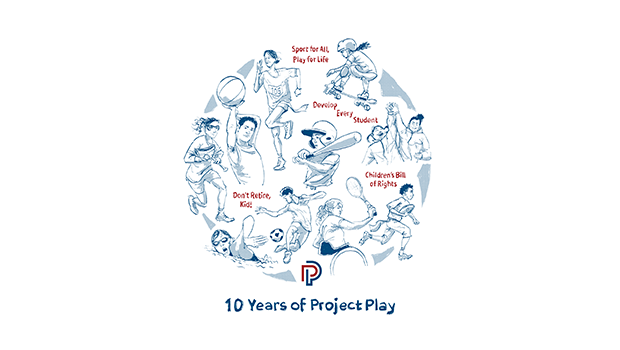The Aspen Institute Sports & Society Program analyzed the landscape of youth sports in Mobile County, Alabama, from January through July 2018. State of Play: Mobile County offers a snapshot of how well adults are serving youth through sports, regardless of zip code or ability.
Findings for this report were guided by a task force of local leaders and obtained through several methods: individual interviews with a broad collection of stakeholders, focus group discussions, youth and adult surveys, existing reports and data, and media accounts.
Some key findings in the report:
- One in three children in Mobile County is overweight, twice the national rate. Nearly 29 percent of youth in Mobile County are overweight and another 22.5 percent are obese. The total number of overweight children exceeds Alabama’s already high numbers for adults.
- Mobile County private school sports start young, shaping the landscape of youth sports broadly. Parents with resources pump money and their volunteer time into travel ball or private school sports, where a feeder system maps out the athletic path for kids from pre-kindergarten through high school. The pathway impacts the viability of public programming and creates sports haves vs. have-nots based on financial resources.
- Girls have fewer sports opportunities than boys in Mobile County. Girls told us that their lack of interest and belief they’re not good enough are keeping them out of sports, but that they want to try volleyball, gymnastics, cheerleading/dance, swimming, and track and field.
- Children here begin playing organized tackle football at very early ages, in contrast with national trends. Among Mobile County youth who play the game, 36 percent started tackle by the age of 6. Half of African-American youth who play tackle football started by the first grade, compared to 30 percent of white children. Some medical experts believe tackle should start in middle school or high school to reduce the number of hits to the head. The Aspen Institute Sports & Society Program published a white paper that concluded that children, football and communities are likely to benefit if flag football becomes the standard way of playing before high school, with proper tackling technique taught in practice settings in the age group leading into tackle.
- Twenty-six percent of youth surveyed said they have played in a game where adults bet money on who won or the final score. Children who have played tackle football, basketball and baseball were by far the most likely to say adults gambled on their games. Adults gambling on youth games has been witnessed by both boys (33 percent) and girls (19 percent).
- The county has relatively few recreation and fitness facilities. In 2015, there were 7.75 such facilities per 100,000 Mobile County residents – slightly better than the state average (7.66) and where the county stood in 2010 (6.78), but still well behind the national average (10.46). Many of Mobile County’s sports facilities are in need of repair.
- Eighty-two percent of county youth said adults encourage them to play sports and/or be physically active. On the other hand, 10 percent said they don’t receive that encourage (and 8 percent said they don’t know).
- About one-third of Alabama families who have a child with a disability reported it’s “very hard” to obtain recreational opportunities. The City of Mobile’s indoor recreational facilities need more than $600,000 in repair to comply with the Americans with Disabilities Act, according to a 2017 analysis by a consultant. Nationally, youth who have disabilities are 4.5 times less active and have obesity rates that are 38 percent higher than other youth.
Our recommendations – located in the Call for Leadership, Game Changer and Ideas sections – offer ideas based on the unique characteristics of Mobile County and are designed to stimulate new thinking. Our major recommendation focuses on setting a new standard for youth sports in Mobile County through the strategic use of public facilities.
Solutions start with shared values that can be applied through the power of the permit, where public oversight over the use of taxpayer-funded facilities is one of the most effective ways to improve the safety and enjoyment of youth in sports. We offer examples of ways to apply the power of the permit.
The Aspen Institute’s youth survey drives much of the analysis in this report. The survey was distributed to 17 elementary, middle and high schools across the country for geographic balance – both in public and private schools – and was taken by 1,721 youth.
Children, as the consumers of youth sports, carry a valuable voice that too often is not reflected in coaching and programming. The No. 1 strategy that can get and keep kids active through sport, as recognized by the Aspen Institute’s Project Play, is Ask Kids What They Want. When children have some measure of control over physical activity, they are more inclined to enjoy themselves and thus continue to move their bodies, becoming active athletes for life. In Mobile County what youth most like about sports is playing with friends (64 percent) and having fun (53 percent). Winning was not in the top five reasons Mobile youth told us they like to play sports.
State of Play: Mobile County is the Aspen Institute’s first assessment of a single U.S. county, and the sixth overall community report. The Aspen Institute has produced regional reports on Southeast Michigan, Western New York, and Greater Rochester and the Finger Lakes, and hyperlocal reports on Harlem and Baltimore. Stakeholders in those communities have taken actions based off our recommendation and are seeing results.
With a passionate sports culture, Mobile County has the opportunity to take action and provide greater quality sport options for all children.
Jon Solomon is editorial director of the Aspen Institute Sports & Society Program and author of State of Play: Mobile County. He can be reached at jon.solomon@aspeninstitute.org. Follow him on Twitter at @JonSolomonAspen.

